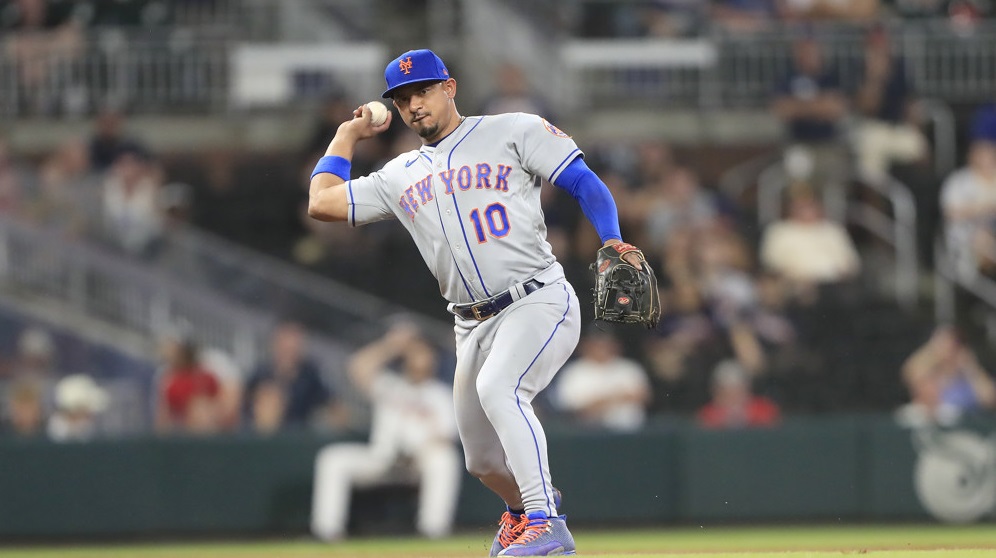BY SEAN ZERILLO
In 16 games with the New York Mets since being traded for Matt Harvey, Devin Mesoraco has provided a big power boost for his new club – hitting five homers with a .913 OPS over 50 at bats. He has channeled his 2014 All-Star form when he hit 25 doubles and 25 homers with a .893 OPS in 384 at bats with the Reds.
The team will enter into a timeshare at catcher between Mesoraco and Kevin Plawecki, as the latter is back with the Mets after breaking his hand on April 11 and Travis D’arnaud is set to miss the rest of the season with a torn UCL.
Comparing the defense
Since his debut in 2015, Plawecki has 16 Defensive Runs Saved over 1,244 innings. He has saved his team 1.29 runs for every 100 innings played at catcher.
Since his 2014 All-Star campaign, Mesoraco is -15 in Defensive Runs Saved over 1,604 innings. He has cost his team .935 runs for every 100 innings played at catcher.
Much of the positive data for Plawecki is due to an outstanding rookie year behind the plate in 2015 and if he can return to that form, he’s probably the better option behind the plate. He had 10 Strike Zone Runs Saved and 5 Adjusted Earned Runs Saved (a stat that attempts to convey staff-handling — think of it as a better form of catcher ERA) over just 70 games and 602 innings, nabbing 87 more strike calls than expected, or about one in every 6.9 innings.
Shared struggles
That efficiency, however, has dropped off steadily since then to 2 Strike Zone Runs Saved in 2016 and -4 in 2017. Plawecki has cost the Mets 36 strikes in his last 37 games, instead of stealing more than one per game as he did in 2015. He does remain at 6 Adjusted Earned Runs Saved for his career.
Mesoraco has never been particularly adept at maximizing called strikes. In that 2014 All-Star campaign, his only season with over 100 games played, Mesoraco finished with -7 Strike Zone Runs Saved. He has cost his team 8 Strike Zone Runs Saved in the 76 games he has played since 2016. He has cost his pitchers 23 strikes in the 24 games he has played in 2018. He’s also totaled -4 Adjusted Earned Runs Saved for his career.
Pitch-blocking: Advantage Plawecki
Mesoraco is also a liability at blocking potential wild pitches. Since the start of the 2016 season, he has blocked just 90 percent of potential wild pitches, a rate closer to Gary Sanchez (89 percent) than it is to Plawecki (93 percent) or 2017 Fielding Bible Award Winner Martin Maldonado (also 93 percent).
Defensing bunts: Advantage Mesoraco
The one area where Mesoraco has excelled defensively is in bunt defense. He has saved five runs defensively on bunt attempts for his career. Plawecki has not recorded a positive or negative value on bunt attempts, and remains at 0 Runs Saved for his career.
SB an area of interest to Mets
In recent seasons the Mets have consistently been one of the weakest teams at defending stolen base attempts, but Plawecki’s value on those steal attempts has been neutral (0 Stolen Base Runs saved for his career).
Mesoraco has been below average at defending steals for his entire career, with a cumulative -11 Stolen Base Runs Saved. He is at -2 since 2016, and has thrown out only one runner in 19 attempts this season. Granted, pitchers are usually more responsible for stolen bases allowed than catchers, but Mesoraco’s long-term numbers indicate struggles in that area.
Mesoraco hitting better than expected
By our Defensive Independent Batting Stats (DIBS), Mesoraco’s Expected OPS this season is .704, far below his actual OPS of .787. This expected production is consistent with both his actual OPS (.711) and Expected OPS (.745) from 2017. They both are short of Plawecki’s actual (.764) and Expected OPS (.848) numbers from 2017 — the best offensive numbers of Plawecki’s career. So Mesoraco has been better in the short term, but the long term remains an unknown for both.
But with Mesoraco’s strong offensive start, Plawecki may need to return to his 2015 defensive form to play his way back into a regular role.



